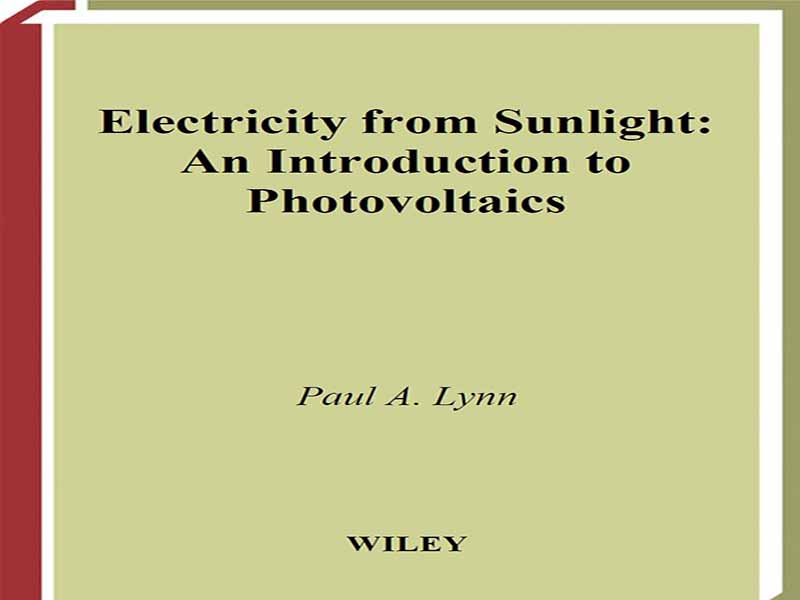- عنوان کتاب: Electricity from Sunlight
- نویسنده: Paul A. Lynn
- حوزه: تولید برق
- سال انتشار: 2010
- تعداد صفحه: 239
- زبان اصلی: انگلیسی
- نوع فایل: pdf
- حجم فایل: 14.5 مگابایت
فتوولتائیک (PV)، فناوری «بدون کربن» که نور خورشید را مستقیماً به الکتریسیته تبدیل میکند، در سالهای اخیر رشد چشمگیری داشته است. در میان انرژی های تجدیدپذیر در تعامل با محیط ساخته شده، PV در حال تبدیل شدن به بخشی از تجربه روزانه شهروندان در کشورهای توسعه یافته است زیرا میلیون ها ماژول PV بر روی پشت بام ها و نمای ساختمان نصب می شود. مردمی که در کشورهای آفتابی زندگی می کنند به طور فزاینده ای در خانه های خورشیدی زندگی می کنند یا برق خود را از نیروگاه های PV بزرگ دریافت می کنند. بسیاری از دولتها در سراسر جهان اکنون مشتاق هستند که برق تجدیدپذیر را به عنوان بخشی ضروری از ترکیب انرژی قرن بیست و یکم ترویج کنند و PV برای آیندهای هیجانانگیز آماده است. این کتاب برای دانشجویان و متخصصانی طراحی شده است که به دنبال معرفی مختصر، معتبر و به روز در مورد PV و کاربردهای عملی آن هستند. من امیدوارم که برای تعداد زیادی از افراد متفکر که مجذوب ایده استفاده از سلولهای خورشیدی برای تولید برق هستند و میخواهند اصول علمی خود را درک کنند، نیز جذاب باشد. این کتاب برخی از مفاهیم چالش برانگیز در فیزیک و الکترونیک را پوشش میدهد، اما لحن آن عمداً سبکتر از متون دانشگاهی است و ریاضیات نسبتاً کمی وجود دارد. من عکسهای رنگی زیادی را که از سرتاسر جهان جمعآوری شدهاند، برای نشان دادن طیف وسیع و متنوع کاربردهای عملی PV اضافه کردهام. با جزئیات بیشتر، فصل 1 زمینه علمی و تاریخی PV را معرفی می کند، چیزی از جادوی این فناوری جدید را پیشنهاد می کند و وضعیت فعلی آن را خلاصه می کند. درمان سلول های خورشیدی سیلیکونی در فصل 2 شامل موادی در فیزیک نیمه هادی ها و نظریه کوانتومی است که با چند معادله کلیدی توصیف شده و با بحث های فراوان پشتیبانی می شود. انواع جدیدی از سلول های نازک فیلم که در سال های اخیر وارد بازار جهانی PV شده اند نیز معرفی شده اند. فصل 3 ویژگیهای ماژولها و آرایههای PV را پوشش میدهد، مشکلات بالقوه اتصال و سایهزنی را مورد بحث قرار میدهد و انواع مختلف سیستمهایی را که خورشید را با یا بدون تمرکز ردیابی میکنند، تشریح میکند. دو دسته اصلی سیستم PV، متصل به شبکه و مستقل، به ترتیب مطالب فصل 4 و 5 را فراهم می کنند و فصل 6 داستان را با برخی از مهم ترین مسائل اقتصادی و زیست محیطی پیرامون پیشرفت چشمگیر PV به پایان می رساند. فناوری فتوولتائیک بهجای تسلط یا تسخیر آن، به دنبال کار با طبیعت است و میل فزاینده ما را برای زندگی هماهنگ با سیاره زمین برآورده میکند. من اطمینان دارم که این کتاب الهام بخش و همچنین اطلاع رسانی خواهد بود و سهم کوچک خود را در آینده انرژی ایفا می کند که به طور فزاینده ای مبتنی بر “الکتریسیته از نور خورشید” است.
Photovoltaics (PV), the ‘ carbon – free ’ technology that converts sunlight directly into electricity, has grown dramatically in recent years. Unique among the renewable energies in its interaction with the built environment, PV is becoming part of the daily experience of citizens in developed countries as millions of PV modules are installed on rooftops and building facades. People living in sunshine countries will increasingly live in solar homes or receive their electricity from large PV power plants. Many governments around the world are now keen to promote renewable electricity as an essential part of the 21 st century ’ s energy mix, and PV is set for an exciting future. This book is designed for students and professionals looking for a concise, authoritative, and up – to – date introduction to PV and its practical applications. I hope that it will also appeal to the large, and growing, number of thoughtful people who are fascinated by the idea of using solar cells to generate electricity and wish to understand their scientifi c principles. The book covers some challenging concepts in physics and electronics, but the tone is deliberately lighter than that of most academic texts, and there is comparatively little mathematics. I have included many colour photographs, gathered from around the World, to illustrate PV ’ s huge and diverse range of practical applications. In more detail, Chapter 1 introduces PV ’ s scientifi c and historical context, suggests something of the magic of this new technology, and summarises its current status. The treatment of silicon solar cells in Chapter 2 includes material in semiconductor physics and quantum theory, described by a few key equations and supported by plenty of discussion. The new types of thin – fi lm cell that have entered the global PV market in recent years are also introduced. Chapter 3 covers the characteristics of PV modules and arrays, discusses potential problems of interconnection and shading, and outlines the various types of system that track the sun, with or without concentration. The two major categories of PV system, grid – connected and stand – alone, provide the material for Chapters 4 and 5 respectively, and Chapter 6 concludes the story with some of the most important economic and environmental issues surrounding PV ’ s remarkable progress. Photovoltaic technology seeks to work with nature rather than to dominate or conquer it, satisfying our growing desire to live in tune with Planet Earth. I trust that this book will inspire as well as inform, making its own small contribution to an energy future increasingly based on ‘ electricity from sunlight ’ .
این کتاب را میتوانید از لینک زیر بصورت رایگان دانلود کنید:
Download: Electricity from Sunlight




































نظرات کاربران